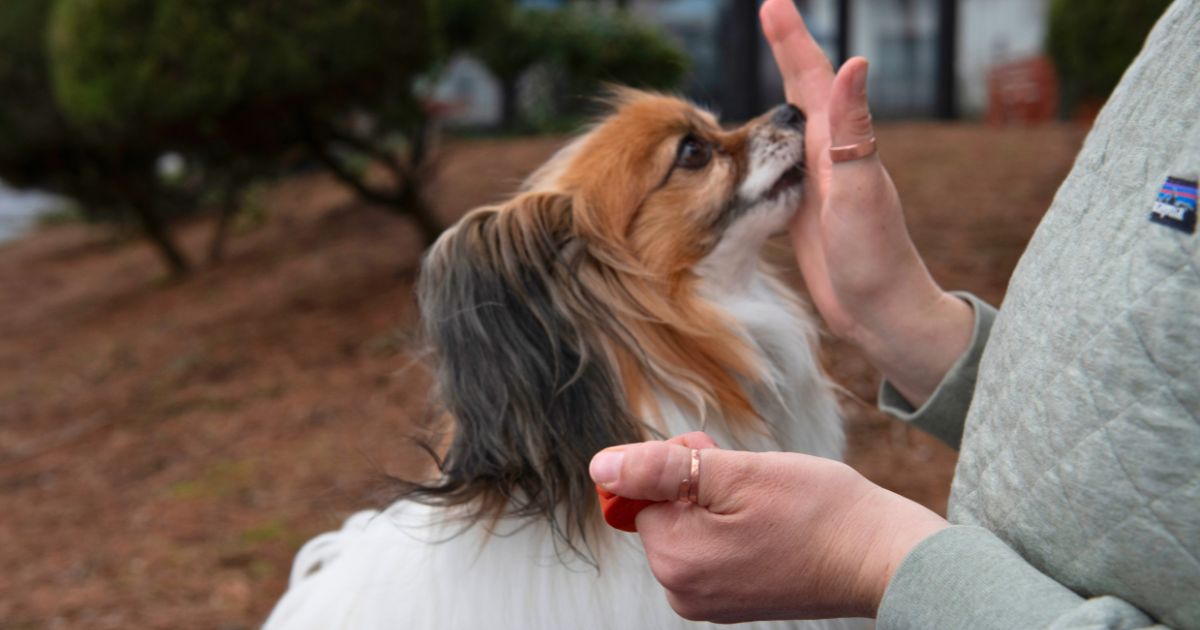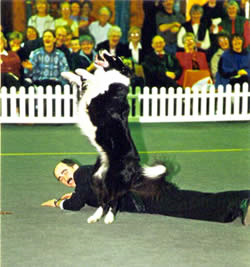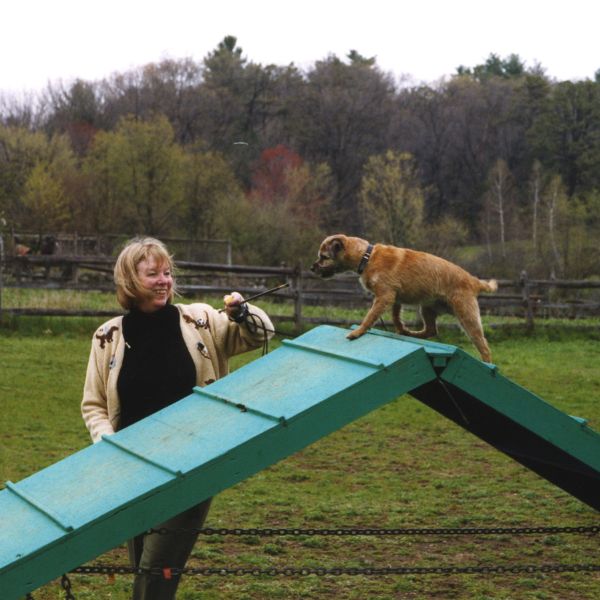
When do I fade the click? How do I fade the click? We hear those questions all the time. The smart-aleck answer is “Never.” Because we don’t “fade” the click. Fading means doing something smaller and smaller until a tiny version of the original stimulus will serve, or until the learner no longer needs outside help to do the behavior. We don’t do that with a click; either you clicked or you didn’t. Period. The term “fading” applies to prompts and cues, not to the marker signal.
Fading a prompt
Here’s an example of fading a prompt. One of my favorite shaping demos consists of teaching a dog to walk backward. I usually start by leaning toward the standing dog, which usually makes him lean away from me or take a step back. Click. I’ve prompted the behavior, he didn’t do it on his own; and I may do that again, two or three more times, clicking any hind foot movement. But then I will “fade” the prompt. I’ll lean just a tiny bit and hope that he will voluntarily step backward. If he does, click! Treat! Then I won’t lean at all and hope that he’ll repeat the behavior without the prompt. Then we can progress to two steps backward, then three, and so on.
When you are shaping behavior, a good trainer is extremely still and quiet. From the moment I’ve faded the prompt I’ll be very careful not to give him any body cues at all, or facial cues or eye contact. I don’t WANT the dog attending to my moves now, or he will become “prompt-dependent,” always looking for messages from me to tell him when to move. When you’re working on a new behavior, don’t cheerlead or encourage your dog with gestures and words; these are meaningless signals you’re just going to have to fade out later. Let the dog figure it out in peace.
At ClickerExpo I did the backup shaping demo on stage with a big Samoyed named Max. I chose Max because I thought the audience could easily see him take a step backward with his big, furry white hind paws. While the owner stood behind me, holding the loose end of Max’s leash, I faced Max and leaned over him a little. The prompt worked; he moved back a step. I clicked during the move, gave him a treat, called him forward, and did it again.
I could easily watch one back foot moving, but when I raised the criteria to two, three, and four steps, I ran into a problem: I couldn’t see the other foot because Max’s big furry white body was in the way. Luckily my co-worker Bill Peña was running a follow-camera on me and the dog, so people in the back of the room could see the demo on a big screen next to the stage. Looking over my shoulder at the screen, I got the audience’s view of Max, too. So I did the rest of the training facing away from Max, watching and clicking his foot movements on the screen, and handing him each treat from behind my back. That REALLY kept me from giving Max any more prompts. He quickly learned to back up as far as space permitted, getting his clicks and taking his treats politely. I never even looked at him. (If you are having a hard time not coaxing and encouraging your dog with words and wiggles, try shaping in a mirror!)
Fading a cue
So, we fade prompts. We also fade cues. Suppose I select a dog for the back-up demo who’s very swift and quickly learns to back halfway across the room. I might now want to add a cue. I could start by leaning forward again while making a pushing gesture with my hand. I would click the first step backward, not waiting for the whole behavior I’ve just shaped. I’m now using the click to shape the response to the cue, not the behavior itself.
Making all your cues as discreet as possible forces the animal to focus sharply on what you say and do, which heightens the accuracy of the cue response.
On the next trial, I might omit the leaning and give him just the pushing gesture. If that gets a response, I might click the third step backward. When he’s backing up continuously until he hears the click, I would teach him to wait for the cue and not just start backing up without it. When he does that, I can assume he understands the new cue.
I could now fade the cue even more by making the gesture smaller and smaller on each try until the dog is rushing backward at a tiny move of one finger. Fading cues is an important part of developing a performance dog for stage or screen or in freestyle dance competitions. The audience sees the amazing behaviors but never sees the small moves that tell the dog what to do.
Making all your cues as discreet as possible forces the animal to focus sharply on what you say and do, which heightens the accuracy of the cue response. I think the fact that the animal is focusing hard and waiting for your information also intensifies the reinforcing effect of the cue. And fading your cues has another benefit: it disciplines you to resist turning learned cues into prompts, yelling louder or waving harder if the animal doesn’t respond. (If the animal doesn’t respond to a cue, of course, you need to work some more on criteria involving that cue; making the cue bigger won’t fix the problem.)
Dropping the click
The click is a whole other matter. First, to solve the beginner’s anxiety, of course, you don’t have to click forever. The click is for teaching behaviors and cues. During the shaping process, we gradually click and treat less often as we require more and longer episodes of behavior to earn a click. Then, once the learner knows what to do and when to do it, for many behaviors, you don’t need to click anymore; a nod, a smile, or a word can tell a dog he’s doing fine.
Life provides all kinds of reinforcers for dogs that know what to do. Doors open, people scratch you in just the right place, you get walks, rides in the car, dinner, and so on. In these daylong exchanges there are many opportunities to make nice results contingent on nice behavior. Maybe you once had to teach your dog his everyday skills in small increments with clicks and treats, but now they are part of life and can be maintained with looser and more general pleasant events.
Furthermore, continuous unnecessary clicks can actually be harmful. The click is a powerful way to convey NEW information to the dog. It should make the dog feel as if he’s solved a puzzle. “Ah-HA! That’s what they want!” People who experience TAGteach, being taught some skill or move with the marker signal, often report a sensation of winning, a feeling of excitement when they hear the tag, or click. That’s an important part of the reinforcing role of the marker.
In fact, once the behavior and the cue have become routine, you probably SHOULD stop clicking. At ClickerExpo, during lecture sessions, I sometimes see attendees repeatedly clicking and treating dogs just for lying down and being quiet when the dog is already lying down and being quiet anyway. Using the click in this way, just to maintain behavior that’s already been learned, may actually devalue the click. TAGteacher Theresa McKeon tells me that too much clicking, especially for already-mastered skills, is actually annoying to her gymnastics students. For TAGteachers, the optimal situation appears to be short intensive periods of tagging for new skills, alternating with longer sessions of practice, games, or other exercises using already-learned skills and reinforcing very sporadically, and with social praise, free time, and other more general reinforcers.
High-level performance “post-click”: Attila Szkukalek and Fly
Here’s another question that outsiders often bring up: “I can see how you don’t always need to click around the house, but what about something hard? How about obedience trials? How can you clicker train for that? You can’t click and treat in the ring!”
Right, and you don’t need to because a) your dog’s behaviors are already trained, and b) you can maintain them with other reinforcers: your well-taught cues. The whole exercise is, or should be, a chain, with each behavior continuing until the handler gives a cue for the next behavior. Properly trained, the dog must be thinking all the time, looking for the next cue; and each cue reinforces the behavior that was going on when the next cue was given.
The results can be spectacular. Attila Szkukalek and his dog Fly are coming from England to ClickerExpo in Newport, Rhode Island, this year. Attila is a superb freestyle artist, an actor as well as a dancer, and so is his dog. Each day during the lunch hour Attila will be showing one of his marvelous routines. People will have a chance to meet with him, question him, and learn from him throughout the weekend.

Attila says on his website, “The majority of freestyle dogs are clicker trained. Since the artistic impression is judged, handlers cannot use compulsive training methods which would subdue the dog’s enjoyment and spirit.”
But you’ll never hear a click during Attila and Fly’s performance; that part is over and done with. Other reinforcers now maintain the extraordinarily complex sets of behaviors. Take, for example, Attila’s charming “Charlie Chaplin” routine. By my rough count, the dog performs at least forty different cued behaviors in about three minutes. Some of these are long-duration, such as scooting backward twenty yards or more; some are carried out multiple times, such as dancing in a circle on the hind legs around the human dancer. Some reflect incredibly refined shaping skills—for example, in some moves, the dog’s facial expression is actually a shaped part of the behavior.
The dog is eager and excited, watching for each cue and responding instantly. What are the cues? They include voice, hand signals, targets (the cane and handkerchief, which are also props in the “story”), and leg, arm, and body moves galore. Each cue is a reinforcer, of course, but there are other reinforcers, too. In his writings about freestyle, Attila mentions specific “favorite” behaviors that are highly rewarding to the dog and can be used to reinforce behaviors a dog finds difficult, such as distance work. In training, Attila also uses the occasional high-value treat. By the way, I have seen Attila perform in England many times now, and I’ve watched his videos assiduously. I defy you to spot any moments in performance when Fly gets a treat.
To make things even more challenging, the performance is also sprinkled with moves and moments that are NOT cues for the dog, such as the actor/dancer’s facial expressions, gestures for the audience’s benefit, and the music. It takes a lot of discipline on the trainer’s part to keep this all straight!
Attila is a biochemist in his day job. He hails from Czechoslovakia originally but now, with his wife and children, lives and works in England. Teaching, training, and competing in freestyle is his “addiction,” as Attila puts it. We are extraordinarily lucky to have persuaded him to bring Fly to ClickerExpo.
Note: This article was originally published on 01/01/2006 and last reviewed on 02/21/2025. We regularly review our content to ensure that the principles and techniques remain valuable and relevant. However, best practices continue to evolve. If you notice anything that may need updating, please feel free to contact us at editor@clickertraining.com.

